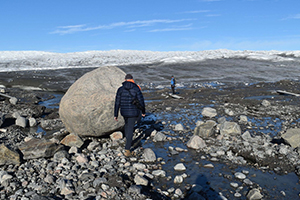Geoscientists map changes in atmospheric CO2 over past 66 million years
 Today atmospheric carbon dioxide is at its highest level in at least several million
years thanks to widespread combustion of fossil fuels by humans over the past couple
centuries.
Today atmospheric carbon dioxide is at its highest level in at least several million
years thanks to widespread combustion of fossil fuels by humans over the past couple
centuries.
But where does 419 parts per million (ppm)—the current concentration of the greenhouse gas in the atmosphere—fit in Earth’s history?
That’s a question an international community of scientists, featuring key contributions by University of Utah geologists, is sorting out by examining a plethora of markers in the geologic record that offer clues about the contents of ancient atmospheres. Their initial study was published this week in the journal Science, reconstructing CO2 concentrations going back through the Cenozoic, the era that began with the demise dinosaurs and rise of mammals 66 million years ago.
Glaciers contain air bubbles, providing scientists direct evidence of CO2 levels going back 800,000 years, according to U geology professor Gabe Bowen, one of the study’s corresponding authors. But this record does not extend very deep into the geological past.
